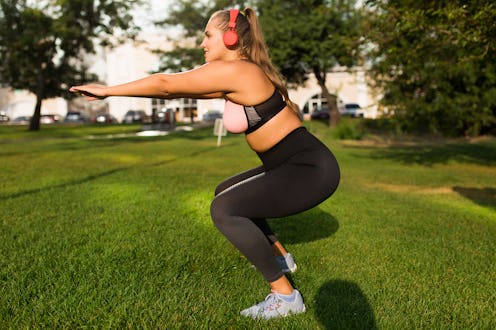Fitness
How Many Squats Should You Do? Here's What Trainers Say
Drumroll, please.

During a lower body workout, there’s a high likelihood that you’re going to be doing at least one round of squats. This classic exercise is one you can do anytime, anywhere — and it’s also incredibly beneficial for multiple parts of your body. But how many squats should you do in order to really see (and feel) results?
If you’re looking for a peachy bum and/or a stronger base for your body, know that a consistent squat routine will get you there. “Squats are a compound exercise that targets multiple muscle groups including the quadriceps, hamstrings, glutes, and core,” says Bryan Macias, a sculpt instructor at Activate House. You can do squats with or without weights, he tells Bustle, which means they’re useful no matter your fitness level. And there are also countless squat variations — from sumo squats to jump squats — so you can always add in new and interesting elements.
Whatever your goals may be, Macias says squats are one of the best functional exercises you can do thanks to the way they mimic everyday movements (think sitting and standing) to help improve your overall strength and mobility. “The effectiveness and versatility of squats make them popular in strength training, bodybuilding, yoga, and general fitness programs,” he says.
With that glowing squat review out of the way, here’s how many squats you should really be doing, plus how to do them with perfect form.
How To Do A Squat
Here, certified personal trainer Rob Wagener breaks down how to squat properly to ensure you make the most of the move.
- Stand with your feet shoulder-width apart and angle your toes slightly outwards.
- Engage your core.
- Sink your hips back into the squat, as if you're sitting in an invisible chair.
- Keep your knees aligned with your toes.
- Put your weight into heels.
- Keep your chest lifted the whole time.
- Once your thighs are parallel to the ground, press into your heels to stand back up.
- Repeat for your desired number of reps.
How Many Squats Should You Do?
When you’re brand new to squats, it’s best to focus more on quality versus quantity as you build up strength and endurance. To get started, Wagener recommends aiming for two to three sets of eight to 12 squats. Go slow and do this many reps with good form.
Repeat this amount two to three times a week until you feel confident with your form and no longer experience any pain or muscle fatigue, Wagener says. From there, feel free to move up a level by doing three to four sets of eight to 15 squats.
Stay at each level until it feels easy. Eventually, you can kick your squat game up another notch by holding a pair of dumbbells in each hand, trying different squat variations, or adding more reps, says Wagener. As you become an advanced squatter, aim for four to five sets of 10 to 20 reps.
“The number that's right for each level is based on individual fitness goals, current conditioning levels, and recovery speed,” he notes. “Pay attention to rest periods for proper recovery between workouts — this is key to building an effective program.”
Something to note: While it may be tempting to pump out as many squats as possible on your journey to a squat-tastic booty, keep in mind that it is possible to overdo it. “Overdoing squats can lead to muscle strain, joint pain, and other injuries,” Macias says.
You’ll know you’re doing too many squats if you have knee, hip, or lower back pain, muscle soreness, or if your performance suddenly tanks. And if you’re too tired to squat with good form, take it as a sign. “It is important to listen to your body and give it the rest and recovery it needs,” Macias says.
How To Get Better At Squats
To upgrade your squat game, you can add other exercises into your routine, like lunges, glute bridges, step-ups, and deadlifts. “These can help target different muscles involved in squatting, while also strengthening the hip flexors to improve overall performance,” Wagener says.
Another key? Take plenty of rest days, Wagener says. Instead of doing squats every single day, do your squat routine two to three times a week. When you aren’t squatting, he suggests stretching, foam rolling, and active rest workouts like yoga, swimming, or walking. Follow this plan and you’ll be a squat superstar in no time.
Studies referenced:
Androulakis-Korakakis, P. (2020). The Minimum Effective Training Dose Required to Increase 1RM Strength in Resistance-Trained Men: A Systematic Review and Meta-Analysis. Sports Med. doi: 10.1007/s40279-019-01236-0.
Sources:
Bryan Macias, sculpt instructor at Activate House
Rob Wagener, certified personal trainer
This article was originally published on